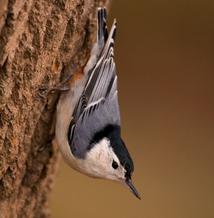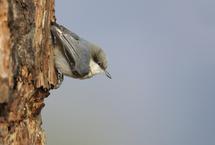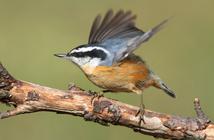saveourplanetearth.com
Call us: (775) 831-1331
Nuthatches
Serious birders can be patient and persistent – single-minded in the pursuit of a sighting, perhaps a little bit crazy and it has been so probably since the beginning of time.
I came across an account of one such birder from 1923, Claude Gignoux:
Nesting of Pigmy (sic) Nuthatches at Lake Tahoe
“On August 15, 1923, I found the nest of a pair of Pigmy Nuthatches (Sitta pygmea) in a hole about ten feet from the ground in an upright post at Brockway, Placer County, California, about 75 yards from the shore of Lake Tahoe.”
This is an excerpt from The Condor, the official journal of the Cooper Ornithological Society, first published in 1899. The Society was founded in 1893 in California; its purpose being “the scientific study of birds, the dissemination of ornithological knowledge, the encouragement and spread of interest in the study of birds, and the conservation of birds and wildlife in general.”
Gignoux’s journal entry goes on to record his observations of this nest, the actions of the parents and the nestlings, how often the nest was visited and the baby birds fed. In one hour, he counted 24 visits to the nest by the adult birds, each carrying a prize of a fly, grub or a worm, which was promptly deposited into the open mouth of one of the young.
There are four species of nuthatches in North America, three of which can be found at Lake Tahoe: pygmy, white-breasted, and red-breasted. The fourth specie, the brown-headed, is found only in the southeastern states, with a small but declining population in the Bahamas.
Nuthatches are small birds with large heads, short legs, square 12-feathered tails, and long, pointed bills. The pygmy is the smallest at about 4 inches long, white-breasted the largest at about 5.5 inches, the red-breasted measures 4.5 inches.
Nuthatches are vocal, using a variety of calls and whistles, with different meanings for each. The red-breasted nuthatch also understands the calls of the chickadee, which has subtle variations that communicate information about the size and risk of nearby predators. The red-breasted nuthatch can interpret these variations and respond appropriately to the communicated threat.
Nuthatches are found in coniferous forests, feeding on seeds, nuts, insects and spiders. One easy way to recognize a nuthatch is by how they move along a tree: up, down and sideways. A nuthatch does not use its tail for balance like the woodpeckers do, instead relying on its sturdy legs to propel itself in jerking hops.
Nuthatches will visit bird feeders to eat suet and sunflower seeds and will store food in tree crevices, under small stones, or in the ground and can remember these secret stores for as long as 30 days.
The brown-headed nuthatch will use a piece of tree bark as a lever to pry up other bark to find the treasures beneath and will even carry this tool from tree to tree or to cover a seed cache.
All nuthatches nest in cavities, either those made by excavating themselves or adopting a previously made or naturally occurring hole in a tree. They then line the cavity with soft materials. Nuthatches are monogamous, the female producing white eggs with red or yellow markings; the clutch size varies, but tends to be larger in the North.
The red-breasted nuthatch smears resin around the entrance to its nest while the white-breasted spreads the juice from crushed beetles around the entrance hole, perhaps to deter squirrels.
When not nesting, in the colder times of the year, nuthatches roost communally to keep warm.
A bird so similar to the nuthatches I wouldn’t know the difference unless I looked it up is the brown creeper, which is about the same size as the red-breasted nuthatch.
The brown creeper is a close relative of the nuthatch, but they are in different families. The creeper is a treecreeper, family Certhiidae, and the nuthatch is in the Sittidae family.
Creepers move in a spiral pattern up the tree, using their sturdy tails for support; nuthatches move up, down and sideways on the tree.
The creeper is brown, blending in with the bark. I heard the song of the brown creeper for at least two years before I finally got to see one, which was on an outing with the Incline Elementary School birding club, hosted by Tahoe Institute for Natural Science. Prior to that outing, I had no idea what was singing that boisterous song.
He’s not easy to spot but his song is distinctive—listen to and learn his song at allaboutbirds.org.
White-breasted nuthatch
Red-breasted nuthatch
Pygmy nuthatch





